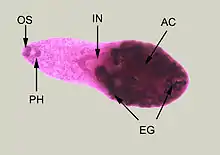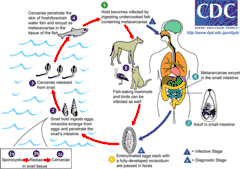Heterophyes heterophyes
Heterophyes heterophyes, or the intestinal fish fluke, was discovered by Theodor Maximaillian Bilharz in 1851. This parasite was found during an autopsy of an Egyptian mummy.[1] H. heterophyes is found in the Middle East, West Europe and Africa.[2] They use different species to complete their complex lifestyle. Humans and other mammals are the definitive host, first intermediate host are snails, and second intermediate are fish. Mammals that come in contact with the parasite are dogs, humans, and cats. Snails that are affected by this parasite are the Cerithideopsilla conica. Fish that come in contact with this parasite are Mugil cephalus, Tilapia milotica, Aphanius fasciatus, and Acanthgobius sp.[2] Humans and mammals will come in contact with this parasite by the consumption of contaminated or raw fish.[3] This parasite is one of the smallest endoparasite to infect humans.[4] It can cause intestinal infection called heterophyiasis.[5]
| Heterophyes heterophyes | |
|---|---|
 | |
| Adult specimen stained with carmine | |
| Scientific classification | |
| Domain: | Eukaryota |
| Kingdom: | Animalia |
| Phylum: | Platyhelminthes |
| Class: | Trematoda |
| Order: | Plagiorchiida |
| Family: | Heterophyidae |
| Genus: | Heterophyes |
| Species: | H. heterophyes |
| Binomial name | |
| Heterophyes heterophyes (Siebold, 1853) | |
| Synonyms | |
| |
Distribution
This species occurs in Egypt, Sudan, Israel, Brazil, Spain, Turkey, Iran, India, and Russia.[6] Common in North Africa, Asia Minor, Korea, China, Japan, Taiwan, and the Philippines. In Egypt, after looking at twelve populations of Cerithideopsilla conica, which is mud snail and carrier of Heterophyes heterophyes, it was found that the most infected snails were found in the Nile Delta compared to the Red sea coast and inland waters of the Delta.[7] The transmission of Heterophyes heterophyes from, Pirenella conica, a snail, to fish which live in Northern Africa in lagoons that are connected to the sea. For transmission to occur from snails to fish the snails had to be larger than 5 mm.[8]
Morphology
Minute teardrop-shaped flukes found in the small intestines of fish-eating birds and mammals. The eggs are hard to tell apart from other related species so there is no accurate estimate of human infection. H. heterophyes is a small trematode, ranging up to 1.4mm long and 0.5mm wide.[4] It is covered with scale-like spikes and those spikes can range from 50–62.[9] Their pharynx is completely developed and connected to the cecum of the small intestines. Their sucker (mouth) is covered with spikes and its covering the genital opening. This means, they share one hole for eating and reproduction. Their testes is located at the posterior of the parasite and the testes are side by side.[4] The ovaries are located in the medial of the parasite, right above the testes.[4] The ventral sucker also known as the acetabulum is located at the ventral of the parasite.[4] The ventral sucker helps them attach to the host. Morphology can change depending on what fish it lives on.
Life cycle

The adult flukes live burrowed between the villi of the host's small intestine. It only takes around 4 to 6 hours for H. heterophyes to get to the small intestines in the definitive host and even faster in hosts that it does not prefer.[10] The eggs that are laid contain a miracidium but do not hatch until they are ingested by a snail (Cerithideopsilla conica[6] in Egypt or Cerithidia cingula in Japan). Inside the snails gut, the miracidium becomes a sporocyst which then begin to produce rediae. The rediae produce cercariae which then exit the snail, swim toward the surface of the water, and slowly fall back down. On their way down, they contact a fish and penetrate into the epithelium of the fish. Here, the cercariae encyst in the muscle tissue. The second intermediate host include freshwater fish: Mugil cephalus, Tilapia nilotica, Aphanius fasciatus, and Acanthogobius sp.[6] The definitive host, such as humans or birds, eats the undercooked or raw meat of a fish and ingest the parasite. Natural definitive hosts are cats, dogs, foxes, wolves, pelicans, and humans.[6]
Epidemiology
People at high risk for infection are those who live by bay waters including fishermen. Infection is acquired by eating raw fish, a common food in areas of heavy endemicity. In endemic areas, people who live near lake shores or river banks usually have a higher rate and intensity of infection than those living a distance from such areas. It is possible that inhabitants of these areas eat more low-salted or improperly cooked fish and that their fish are obtained from polluted water. It is common practice for people to defecate on the lake shores and river banks or from their boats while fishing. In rural areas of Egypt there was a higher chance of being infected with H. heterophyes due to being a lower socioeconomic area and not having easy access to medical services.[11]
Pathology
Each worm causes a mild inflammatory reaction at its site of contact with the intestine. In heavy infections which are common cause damage to the mucosa and produce intestinal pain and mucosa diarrhea. Sometimes eggs can enter the blood and lymph vascular systems through mucosa go into the ectopic sites in the body. The heart can be affected with tissue reaction in the valves and myocardium that cause heart failure. Eggs can also get into the brain or spinal cord and cause neurological disorders and sometimes fatalities. Antigen and immune complex deposits left by H. heterophyes in the brain and kidneys of mice prove that there are changes in these tissues of the infected.[12]
H. heterophyes can cause intestinal infection called heterophyiasis. The infection can be asymptomatic or intestinal discomfort and mucous diarrhea.[13] This parasite can start cell apoptosis in the intestinal epithelial cell, at early infection. This infection can cause enlarged intestinal crypts, acute to chronic inflammation, atrophy, and fusion and shortening of the intestinal villi.[13] After early infection this parasite will inhibit apoptosis which can cause the decrease in caspase-3 and NF-jB. Caspase-3 and NF-jB are protein that are essential to induce programmed cell death, apoptosis.[13]
Diagnosis
Diagnosis done by stool examination is difficult when adult worms are not present because the eggs are hard to distinguish from C. sinensis.
Treatment
Praziquantel, a quinolone derivative. The effect of praziquantel on H. heterophyes causes deep lesions on their teguments, and when exposed to praziquantel over a longer period of time leads to even deeper lesions.[14]
References
- Chai, Jong-Yil; Jung, Bong-Kwang (2017-09-01). "Fishborne zoonotic heterophyid infections: An update". Food and Waterborne Parasitology. IAFWP/WAAVP 2017 Symposium on Food and Waterborne Parasites. 8–9: 33–63. doi:10.1016/j.fawpar.2017.09.001. ISSN 2405-6766. PMC 7034020. PMID 32095640.
- Chai, Jong-Yil; Jung, Bong-Kwang (2020-01-01). "Foodborne intestinal flukes: A brief review of epidemiology and geographical distribution". Acta Tropica. 201: 105210. doi:10.1016/j.actatropica.2019.105210. ISSN 0001-706X. PMID 31600520.
- Ashour, Dalia S.; Othman, Ahmad A.; Radi, Dina A. (2014-08-01). "Insights into regulatory molecules of intestinal epithelial cell turnover during experimental infection by Heterophyes heterophyes". Experimental Parasitology. 143: 48–54. doi:10.1016/j.exppara.2014.05.003. ISSN 0014-4894. PMID 24852217.
- Bogitsh, Burton J.; Carter, Clint E.; Oeltmann, Thomas N. (2019-01-01), Bogitsh, Burton J.; Carter, Clint E.; Oeltmann, Thomas N. (eds.), "Chapter 10 - Visceral Flukes", Human Parasitology (Fifth Edition), Academic Press, pp. 175–191, doi:10.1016/b978-0-12-813712-3.00010-2, ISBN 978-0-12-813712-3, retrieved 2020-02-28
- Daoud, Ahmed (February 2012). "254 Experimental Heterophyiasis". World Allergy Organization Journal. 5 (Suppl 2): S83. doi:10.1097/01.wox.0000412011.68985.61. ISSN 1939-4551. PMC 3512869.
- Chai J. Y., Darwin Murrell K. & Lymbery A. J. (2005). "Fish-borne parasitic zoonoses: Status and issues". International Journal for Parasitology 35(11–12): 1233–1254. doi:10.1016/j.ijpara.2005.07.013.
- Taraschewski, H. (1985). Investigations on the prevalence of Heterophyes species in twelve populations of the first intermediate host in Egypt and Sudan. The Journal of Tropical Medicine and Hygiene, 88(4), 265–271.
- Taraschewski, H., & Paperna, I. (1981). Distribution of the snail Pirenella conica in Sinai and Israel and its infection by Heterophyidae and other trematodes. Marine Ecology, Progress Series, 5(2), 193–205.
- Chai, Jong-Yil; Shin, Eun-Hee; Lee, Soon-Hyung; Rim, Han-Jong (October 2009). "Foodborne Intestinal Flukes in Southeast Asia". The Korean Journal of Parasitology. 47 (Suppl): S69–S102. doi:10.3347/kjp.2009.47.S.S69. ISSN 0023-4001. PMC 2769220. PMID 19885337.
- Taraschewski, H. (1987). Experiments on habitat selection of Heterophyes species in different definitive hosts. Journal of Helminthology, 61, pp 33–42. doi:10.1017/S0022149X00009688.
- El-Shazly, A. M., El-Nahas, H. A., Soliman, M., Sultan, D. M., Abedl, T. A., & Morsy, T. A. (2006). The reflection of control programs of parasitic diseases upon gastrointestinal helminthiasis in Dakahlia Governorate, Egypt. Journal of the Egyptian Society of Parasitology, 36(2), 467–480.
- Daoud, A. (2012). Allergies in Other Diseases: 254 Experimental Heterophyiasis: Histopathological & Immunological Study. The World Allergy Organization Journal, 5(Suppl 2), S100.
- Ashour, Dalia S.; Othman, Ahmad A.; Radi, Dina A. (August 2014). "Insights into regulatory molecules of intestinal epithelial cell turnover during experimental infection by Heterophyes heterophyes". Experimental Parasitology. 143: 48–54. doi:10.1016/j.exppara.2014.05.003. ISSN 0014-4894. PMID 24852217.
- Taraschewski, H., Mehlhorn, H., Bunnag, D., Andrews, P., & Thomas, H. (1986). Effects of praziquantel on human intestinal flukes (Fasciolopsis buski and Heterophyes heterophyes). Zentralblatt für Bakteriologie, Mikrobiologie und Hygiene. Series A: Medical Microbiology, Infectious Diseases, Virology, Parasitology, 262(4), 542–550.
- Roberts, Larry, and John Janovy. Gerald D. Schmidt & Larry S. Roberts' Foundations of Parasitology. 8th ed. New York: McGraw-Hill, 2009. 291-92. Print.